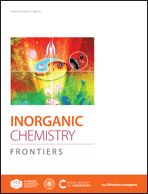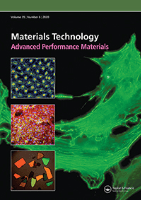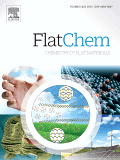
SmartMat
Scope & Guideline
Elevating Material Science through Cutting-edge Discoveries.
Introduction
Aims and Scopes
- Smart Materials Development:
Research on the design, synthesis, and application of materials that can respond dynamically to environmental stimuli, enhancing their functionality in real-time applications. - Energy Storage and Conversion:
Exploration of novel materials for energy storage solutions, including batteries and supercapacitors, emphasizing sustainability and efficiency. - Nanotechnology and Nanomaterials:
Investigation of nanoscale materials and their properties, including applications in electronics, sensing, and catalysis, with a focus on enhancing performance through innovative engineering. - Biocompatible and Biomedical Materials:
Development of materials suitable for medical applications, including drug delivery systems and tissue engineering, aimed at improving patient outcomes and safety. - Sensing and Actuation Technologies:
Research on materials that enable advanced sensing capabilities and actuation mechanisms, critical for applications in robotics, healthcare, and environmental monitoring. - Machine Learning and AI Integration:
Utilization of machine learning techniques to accelerate material discovery, characterization, and optimization processes, paving the way for smarter and more efficient material solutions.
Trending and Emerging
- Sustainable and Eco-Friendly Materials:
There is an increasing focus on developing materials that are sustainable and environmentally friendly, aligning with global efforts to address climate change and reduce waste. - Advanced Energy Materials:
A significant trend is the research on advanced materials for energy applications, particularly in the fields of batteries, fuel cells, and supercapacitors, highlighting the importance of energy efficiency and storage. - Integration of AI and Machine Learning:
The integration of AI and machine learning in material design and testing is rapidly emerging as a key theme, enabling faster discovery and optimization of materials with enhanced properties. - Flexible and Wearable Electronics:
The development of flexible and wearable electronic devices is gaining traction, driven by advancements in materials that can conform to various shapes and maintain performance under mechanical stress. - Smart Healthcare Solutions:
Emerging themes in smart healthcare materials are becoming increasingly relevant, particularly those aimed at improving diagnostics, drug delivery, and tissue engineering. - Nanostructured Materials for Catalysis:
Research on nanostructured materials specifically for catalysis applications is on the rise, reflecting the ongoing need for efficient processes in energy conversion and environmental remediation.
Declining or Waning
- Traditional Bulk Materials:
Research on conventional bulk materials is becoming less prominent as the focus shifts towards advanced composites and nanomaterials, which offer superior properties and functionalities. - Static Sensors and Actuators:
The development of static sensing technologies is waning, as there is a growing demand for dynamic, responsive systems that can adapt to changes in their environment. - Basic Theoretical Studies:
Papers focused solely on theoretical models with limited experimental validation are decreasing, as the journal increasingly favors studies that combine theory with practical applications. - Single-Function Materials:
The trend is moving away from materials designed for a single function, with a clear preference for multifunctional materials that can perform multiple tasks simultaneously.
Similar Journals

ADVANCED FUNCTIONAL MATERIALS
Exploring New Frontiers in Materials ScienceADVANCED FUNCTIONAL MATERIALS is a leading journal published by WILEY-V C H VERLAG GMBH, prominently recognized in the fields of biomaterials, chemistry, condensed matter physics, and materials science. With an impressive impact factor and a distinguished position in the Q1 quartile across multiple categories including nanoscience and nanotechnology, this journal serves as a vital platform for researchers and professionals committed to innovating in functional materials. Since its inception in 2000, ADVANCED FUNCTIONAL MATERIALS has published high-quality peer-reviewed articles that push the boundaries of materials science, exploring new frontiers in electronic, optical, and magnetic materials. The journal's dedication to open access ensures that its groundbreaking findings are readily available to a global audience, fostering collaboration and knowledge-sharing among scholars and practitioners in the field. For those seeking to stay at the forefront of materials research, ADVANCED FUNCTIONAL MATERIALS is an essential resource.

Accounts of Materials Research
Connecting minds in the multidimensional world of materials.Accounts of Materials Research is a premier journal published by the American Chemical Society, focusing on the multidimensional field of materials science. With a robust impact factor and a commitment to open-access research, it serves as a vital platform for leading-edge discoveries from 2020 to 2024. The journal has rapidly ascended to the top quartile in multiple categories, including Chemical Engineering, Materials Chemistry, and Polymers and Plastics, demonstrating its significant influence within the academic community. Recognized by Scopus as a key resource—with remarkable rankings that place it in the 95th percentile of its field—Accounts of Materials Research is devoted to publishing high-quality, innovative research that addresses critical challenges in materials development and implementation. This journal is essential for researchers, professionals, and students seeking to stay informed about the latest advancements and collaborative opportunities within the interdisciplinary landscape of materials science.

Inorganic Chemistry Frontiers
Advancing the Boundaries of Inorganic ChemistryInorganic Chemistry Frontiers, published by the esteemed Royal Society of Chemistry, stands at the forefront of advancements in the field of inorganic chemistry, boasting a prestigious Q1 ranking in its category as of 2023 and an impressive Scopus Rank of #3 out of 79, placing it in the 96th percentile. Since its inception in 2014, this journal has provided a robust platform for high-quality research that spans the diverse and rapidly evolving areas of inorganic chemistry. As an open-access journal, it ensures that the findings presented are readily accessible to researchers, educators, and practitioners globally, fostering an inclusive environment for the dissemination of knowledge. With its rigorous peer-review process, Inorganic Chemistry Frontiers aims to facilitate interdisciplinary dialogue and innovation, making it an essential resource for anyone dedicated to exploring the myriad applications and theoretical advancements within inorganic chemistry.

InfoMat
Empowering Scholars with Cutting-Edge Insights in Materials ChemistryInfoMat is a premier open-access journal published by WILEY that serves as a vital resource for scholars and practitioners in the fields of materials science, materials chemistry, and related disciplines. Since its inception in 2019, this journal has rapidly ascended in academic stature, currently holding a prestigious Q1 ranking across multiple categories, including Electronic, Optical and Magnetic Materials, Materials Chemistry, and Surfaces, Coatings and Films, showcasing its significant impact and relevance. With a commendable impact factor and a comprehensive scope, InfoMat provides a platform for high-quality research that drives innovation in the materials domain, appealing to researchers, professionals, and students alike. The journal’s open-access model enhances visibility and accessibility of cutting-edge studies, fostering a collaborative and informed scientific community. Based in the United Kingdom, InfoMat continues to shape the future of materials research through its commitment to excellence and accessibility.

MATERIALS TECHNOLOGY
Transforming Ideas into Material SolutionsMATERIALS TECHNOLOGY is a prestigious academic journal published by Taylor & Francis Ltd, based in the United Kingdom. With an ISSN of 1066-7857 and an E-ISSN of 1753-5557, this journal has established itself as a vital resource in the fields of Condensed Matter Physics, Materials Science, Mechanical Engineering, and Mechanics of Materials, earning a Q2 ranking in multiple categories as of 2023. With a rich publication history that dates back to the early 1970s, it serves as an essential platform for disseminating innovative research and developments in materials technology. Although not available through Open Access, the journal continues to attract contributions from leading researchers, ensuring high-quality articles that advance knowledge in the materials domain. The journal's commitment to excellence is reflected in its notable Scopus rankings, placing it within the 70th to 78th percentiles across several engineering and physics categories. As a vital resource for researchers, professionals, and students alike, MATERIALS TECHNOLOGY plays a critical role in shaping the future of materials science and engineering.

Energy & Environmental Materials
Empowering a Greener Future with Innovative DiscoveriesEnergy & Environmental Materials, published by WILEY, is an esteemed academic journal dedicated to pioneering research in the multifaceted domains of energy, environmental science, and materials science. Since its inception in 2018, this journal has rapidly established itself as a leading platform, holding a prestigious Q1 ranking across multiple categories including Renewable Energy, Sustainability, and Waste Management, reflecting its significant contributions to advancing knowledge in these critical areas. With a robust Scopus ranking that positions it in the top percentile for Environmental Science and Materials Science, it caters to a diverse audience of researchers, professionals, and students seeking cutting-edge findings and practical applications in energy efficiency and sustainable materials. This open-access journal facilitates the dissemination of innovative research and aims to bridge the gap between scientific exploration and real-world solutions for a sustainable future. The editorial team encourages submissions that explore both theoretical and practical aspects, ensuring that every publication not only contributes to the academic landscape but also drives impactful change in energy and environmental practices.

Materials Futures
Shaping the future of materials science through open access.Materials Futures, an esteemed journal published by IOP Publishing Ltd, stands out as a pivotal resource in the field of Materials Science, with a particular emphasis on Biomaterials. Launched in 2022 and operating under an Open Access model, the journal aims to foster accessibility and rapid dissemination of pioneering research, thus catering to the diverse needs of researchers, professionals, and students globally. With a commendable Scopus Rank of #46 out of 137 in its category, placing it in the 66th percentile, and recognized as a Q1 journal as of 2023, Materials Futures provides a vital platform for cutting-edge studies and innovations that address contemporary challenges in materials science. As the journal evolves through its convergence period from 2022 to 2024, it continues to attract high-quality submissions aimed at advancing knowledge and applications within the biomaterials sector, reflecting its commitment to contributing vital insights and fostering collaboration across disciplines. Explore Materials Futures for your research endeavors and join a community dedicated to shaping the future of materials.

Journal of Inorganic and Organometallic Polymers and Materials
Driving Excellence in Polymer Science and Materials ChemistryThe Journal of Inorganic and Organometallic Polymers and Materials, published by SPRINGER, is a premier academic journal dedicated to advancing the field of materials science, particularly in the domains of inorganic and organometallic polymers. Established in 1996, this journal has successfully converged multiple years of research, reflecting the dynamic evolution of the field through to 2024. With an impressive Scopus Rank placing it in the top 81st percentile in both Materials Chemistry and Polymers and Plastics, it is recognized for its significant contributions and innovations. The journal is classified in the prestigious Q2 Category, indicating its influence and relevance among leading publications. While it operates under a subscription model, the journal is committed to disseminating cutting-edge research, providing insights that empower researchers, professionals, and students to push the boundaries of materials chemistry and polymer science. Its focus on high-quality, peer-reviewed articles ensures that readers are equipped with the latest findings and methodologies that drive this exciting and rapidly evolving field.

FlatChem
Advancing the Frontiers of Materials ScienceFlatChem, an esteemed journal published by ELSEVIER, serves as a premier platform for disseminating high-quality research in the dynamic fields of ceramic and composite materials, electronic and optical materials, materials chemistry, and surfaces, coatings, and films. Since its inception in 2017, the journal has garnered a robust reputation, evidenced by its rank in the top quartile (Q1) across multiple categories, including a commendable rank of #25/127 in Ceramics and Composites and #49/284 in Electronic, Optical and Magnetic Materials. With a focus on pioneering advancements and innovative methodologies, FlatChem not only highlights cutting-edge research but also promotes collaboration and knowledge exchange within the scientific community. The journal’s impact is underscored by its impressive rankings in Scopus, marking it as a vital resource for researchers, professionals, and students aiming to stay at the forefront of materials science. As an open-access journal, it ensures that groundbreaking findings are readily accessible, fostering a broader understanding and application of materials innovation worldwide. The journal is based in the Netherlands, with its headquarters located at RADARWEG 29, 1043 NX AMSTERDAM, NETHERLANDS. Join the vibrant community contributing to FlatChem and engage with the forefront of material advancements.

Energy Storage Materials
Fueling progress in energy engineering and material science.Energy Storage Materials, an esteemed journal published by Elsevier, serves as a pivotal platform for the advancement of knowledge in the vital fields of energy engineering, materials science, and sustainability. Established in 2015, it has quickly ascended to the top echelons of academic publishing, boasting an impressive Q1 ranking in categories such as Energy Engineering and Power Technology, Materials Science, and Renewable Energy, Sustainability and the Environment, all as of 2023. The journal's high impact factor underscores its significance and relevance, with Scopus rankings placing it among the elite in its domains. Through a commitment to rigorous peer review and open scientific discourse, Energy Storage Materials aims to foster innovative research and applications that address the global energy challenge. This journal is essential reading for researchers, professionals, and students dedicated to enhancing energy storage technologies and contributing to a sustainable future.